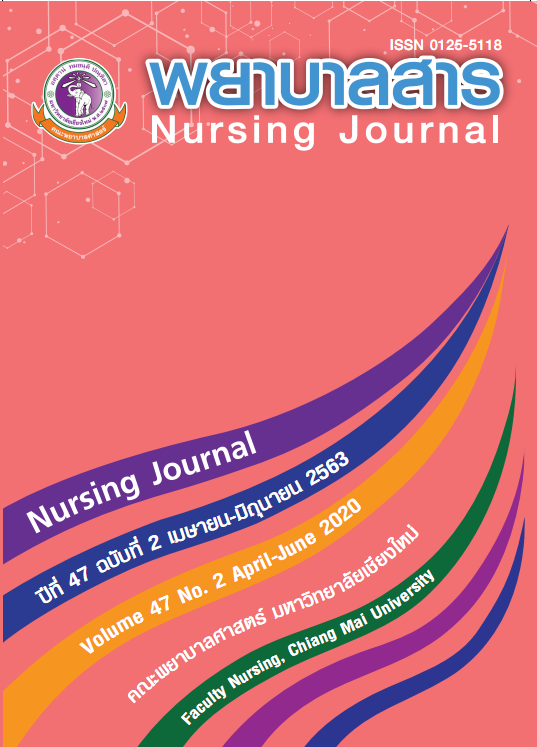Factors Related to Anxiety of First-time Fathers During Labour
Keywords:
fathers’ age, social support, anxiety, first-time fathers, childbirth, labour periodAbstract
First-time fathers usually experience anxiety while their wives are in labour. It is often overlooked because most people pay attention to the mothers. The purpose of this descriptive correlational research study was to explore the anxiety of first-time fathers during their wife’s labour and other related factors. The subjects were selected following the inclusion criteria and consisted of 85 fathers who brought their wives to the labour room at Chiang Mai Health Promoting Hospital from August to October 2015. The research tools were the State-Trait Anxiety Inventory [STAI] form Y-1 by Spielberger (1983), Thai version by Nontasak, Iamsupasit & Thapinta (1995) and the Fathers Social Support Questionnaire developed by Ratchaneewan Charuloedphong and Nantaporn Sansiriphun based on the social support concept by House (1981) and literature reviewed. Descriptive statistics and Pearson’s Product moment correlation were used to analyze the data.
Results of the study revealed that:
- Most subjects had moderate level of anxiety (68.30%) while the mean score for anxiety was 43.29 (S.D. = 6.07);
- Most subjects (62.35%) received a high level of social support while the mean score
for social support was 3.80 (S.D. = .49);
- The subjects (34.20%) were of the ages 20 – 25 years old and 26 – 30 years old
(29.40%). The mean age was 28.51 (S.D. = 5.95); and
- Social support had a negative correlation with the anxiety of first-time fathers during the childbirth labour of their wives (r = -.274, p < .05) while there was no correlation between the first-time fathers’ age and their level of anxiety.
These finding suggest that first-time fathers should be assessed for anxiety. Nurses and midwives should develop strategies to decrease the anxiety of the father while their wives are in labour by providing support which meets the needs of the fathers.
References
B?ckstr?m, C., & Wahn, E. H. (2011). Support during labour: firs t-time fathers’ descriptions of requested and received support during the birth of their child. Midwifery, 27 (1), 67-73.
Brown, M. A. (2012). Fathers’ experience accompanying labour an d birth. Journal of Midwifery, 20 (5), 339-344.
Cabrera, N., Tamis-Lemonda, C. S., Bradley, R. H., Hofferth, S., & Lamb, M. E. (2000). Fatherhood in the twenty-first century. Child Development, 71 (1), 127-136.
Chandler, S., & Field, A. P. (1997). Becoming a father first-time fathers’ experience of labor and delivery. Journal of Nursing Midwifery, 42 (1), 17-24.
Genesoni, L, & Tallandini, M. A. (2009). Men’s psychological transition to fatherhood: an analysis of the literature, 1989-2008. Birth, 36 (4), 305-318.
Hildingsson, I., Cederlof, L., & Widen, S. (2010). Fathers’ birth experience in relation to Midwifery care. Journal of Women and Birth, 24 (3),129-136.
House, J. S. (1981). Work stress and social support. Mass: Addison-Wesley.
Hsin-Tzu, L., Kuan-Chia, L., Shu-Chen, C., Chien-Huel, K., Chieh-Yu, L., & Su-Chen, K. (2009).A birth education program for expectant fathers in Taiwan: Effect on their anxiety. Journal of Birth, 36 (4), 289-296.
Johnson, M. (2002). The implications of unfulfilled expectations and perceived pressure to attend the birth on men’s stress levels following birth attend ance: A longitudinal study. Journal of Psychosomatic Obstetic Gynaecology, 23 (3), 173-182.
Johnson, M., & Baker, R. S. (2004). Implication of coping repertoire as predictors of men’s stress, anxiety and depress following pregnancy, childbirth and miscarriage: Longitudinal study. Journal of Psychosomatic Obstetrics and Gynecology, 25(2), 87-98.
Johanson, M., Hildingsson, I., & Fenwick, J. (2013). Important factors working to mediate Swedish fathers’ experiences of a caesarean section. Journal of Midwifery, 29 (9), 1041-1049.
Katumarn, P. (2010). Father Role. Retrieved from http://www.si.mahidol.ac.th/sidoctor/e-pl/admin/article_files/279. (In Thai)
Pender, N. J. (1987). Health promotion in nursing practice (2nd ed.) New York: Appleton & Lange.
Poh, H. L., Koh, S. S., Soew, H. C., & He, H. G. (2014). First-time fathers’ experiences and needs during pregnancy and childbirth: A descriptive qualitative study. Journal of Midwifery, 30 (6), 779-787.
Premberg, A., Carlson, G., Hellstr?m, A., & Berg, M. (2011). First-time fathers’ experience ofchildbirth–A phenomenal. Journal of Midwifery, 27 (6), 848-853.
Sansiriphun, N., Baosoung, C., Klunklin, A., Kantaruksa, K., & Liamtrirat ,S., (2014). Experience of first time father during labor and delivery period. Nursing Journal, 41, 143-157. (In Thai)
Sapkota, H., Kobayashi, T., & Takase, M., (2012). Husbands’ experience of supporting their wivesduring childbirth in Nepal. Journal of Midwifery, 28 (1), 45-51.
Sengane, M. L., & Cur, D. (2009). The experience of black fathers concerning support for their wives/partners during labour. Journal of Democratic Nursing Oraganization of South Africa, 32 (1), 67-73.
Schytt, E., & Bergstrom, M. (2014). First-time fathers’ expectation and experience of childbirth inrelation to age. Journal of Midwifery, 30 (1), 82-88.
Spielberger, C. D. (1983). Manual for the State–Trait Anxiety Inventory: STAI (Form Y). Palo Alto, CA: Consulting Psychologists Press.
Spielberger, C. D. (1976). The nature and measurement of anxiet y. In C. D. Spielberger, & R.Diaz-Guerrero (Eds.), Cross–cultural anxiety (pp. 3-12). Washington: Hemisphere.
Story, T. W., Burgard, A. S., Lori, R. J., Taleb, F., Ali, A. N., & Hoque, E. D. (2012). Husbands’ involvement in delivery care utilization in rural Bangladesh: A qualitative study. Journal of Biomedical Central of Pregnancy and Childbirth, 12 (1), 1-12.
Walsh, D. (2012). Evidence and skills for normal labour and birth (2 nd ed.). Routledge: Abingdon.
Downloads
Published
How to Cite
Issue
Section
License
บทความที่ได้รับการตีพิมพ์เป็นลิขสิทธิ์ของวารสารพยาบาลสาร
ข้อความที่ปรากฏในบทความแต่ละเรื่องในวารสารวิชาการเล่มนี้เป็นความคิดเห็นส่วนตัวของผู้เขียนแต่ละท่านไม่เกี่ยวข้องกับมหาวิทยาลัยเชียงใหม่ และคณาจารย์ท่านอื่นๆในมหาวิทยาลัยฯ แต่อย่างใด ความรับผิดชอบองค์ประกอบทั้งหมดของบทความแต่ละเรื่องเป็นของผู้เขียนแต่ละท่าน หากมีความผิดพลาดใด ๆ ผู้เขียนแต่ละท่านจะรับผิดชอบบทความของตนเองแต่ผู้เดียว






